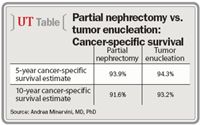Article
Renal cell carcinoma treated with partial nephrectomy or enucleation produce equivalent results
Author(s):
Patients with localized renal cell carcinoma treated with either partial nephrectomy or simple tumor enucleation have equivalent results in terms of local recurrence and cancer-specific survival after an estimated 10 years' follow-up.
Florence, Italy-Patients with localized renal cell carcinoma treated with either partial nephrectomy or simple tumor enucleation have equivalent results in terms of local recurrence and cancer-specific survival after an estimated 10 years' follow-up, according to findings from a recent study.
"This is the first multicenter, comparative study performed that shows oncologic equivalence between the two surgical methods," said first author Andrea Minervini, MD, PhD, consultant urologist at the University of Florence, Florence, Italy.
For the study, which was presented at the 2011 European Association of Urology annual congress in Vienna, Austria and published in the Journal of Urology (2011; 185:1604-10), Dr. Minervini and colleagues prospectively analyzed 1,519 patients who were stratified to undergo either partial nephrectomy (982 patients, 64.7%) or tumor enucleation (537 patients, 35.3%).
Median follow-up was around 6 years for both groups, with 5- and 10-year cancer-specific survival estimates of 93.9% and 91.6% after partial nephrectomy and 94.3% and 93.2% after simple enucleation (p=.94). Type of procedure adopted was not a significant predictor for either cancer-specific survival or progression-free survival.
The patients were also stratified according to age, pathologic classification, and tumor grade. No differences were observed between the two techniques for young and old patients; pT1a, pT1b, and pT3a RCC; and grade 1, grade 2, and grade 3 RCC.

Patients were also analyzed according to the surgical volume of the participating centers. No differences were observed between partial nephrectomy and tumor enucleation.
The researchers did not collect data on overall survival. In addition, full clinical data were not recorded, which might limit the prospective projected results of this study. Dr. Minervini pointed out, however, that the large number of patients-more than 5,000-secures the obtained results.
In an earlier prospective pathologic study, Dr. Minervini and colleagues showed that dissecting the tumor bluntly removes the tumor tissue even if tumor cells have invaded beyond the capsule (Eur Urol 2009; 55:1410-8).
In tumor enucleation, the dissection of the tumor follows the natural cleavage plane between the peritumoral pseudo capsule and the renal parenchyma without removing a visible rim of healthy renal tissue.
"The margins are always negative with tumor enucleation, while they can be positive with standard nephron-sparing surgery because the growth of RCC is not spherical and can invade healthy kidney tissue," Dr. Minervini said.
In recent years, tumor enucleation has obtained a wider level of acceptance based on the lack of correlation between the width of the resection margin and the risk of disease progression/local recurrence.
The results obtained from this study have led Dr. Minervini to propose tumor enucleation as standard treatment in RCC because of the procedure's lower complication rate compared with those seen with partial nephrectomy. Tumor enucleation can also be performed without warm ischemia and can therefore be a good alternative to partial nephrectomy, especially for larger pT1b tumors. In such cases, partial nephrectomy can carry a risk to remove a substantial part of healthy normal parenchyma around the tumor and damage important vessels and collecting systems, Dr. Minervini said.
Newsletter
Stay current with the latest urology news and practice-changing insights — sign up now for the essential updates every urologist needs.















